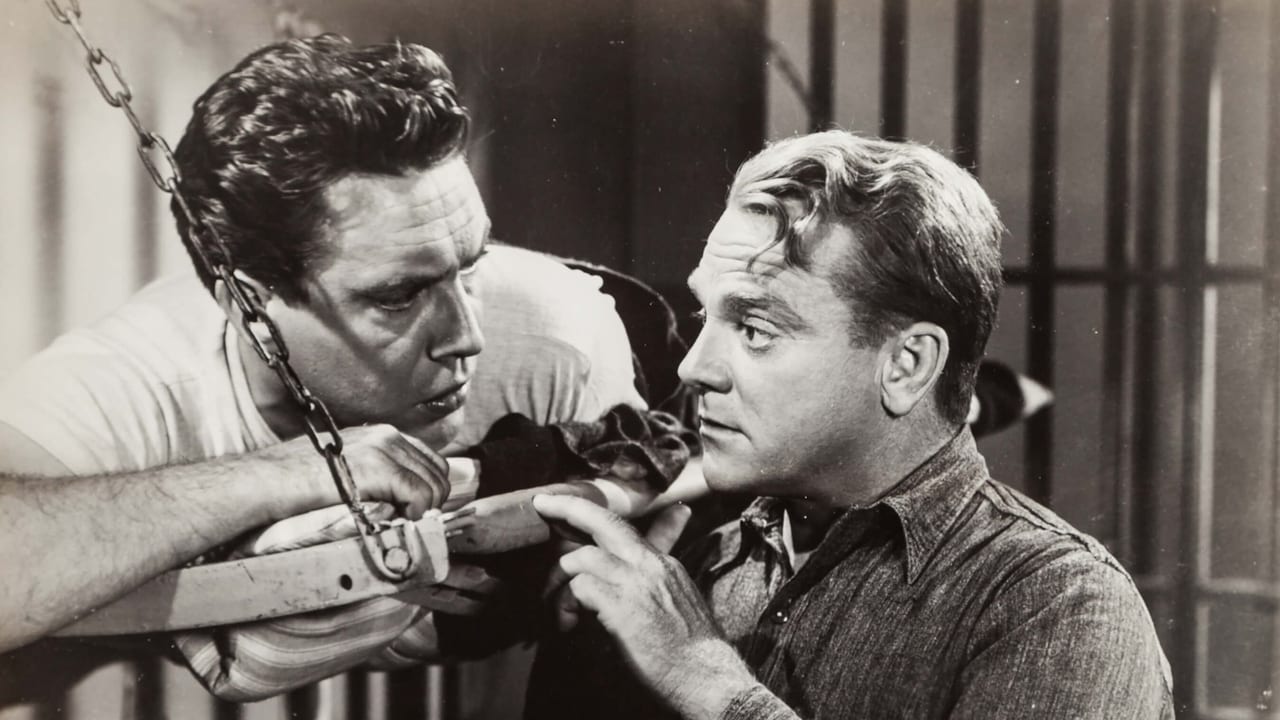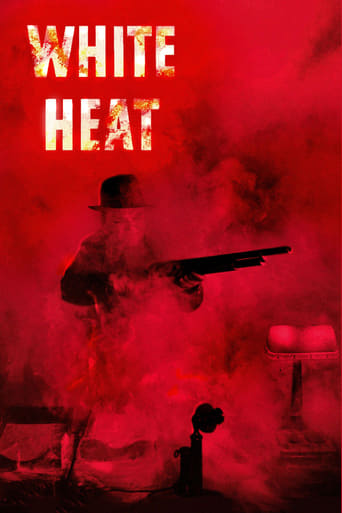

Producer: Louis F. Edelman. Copyright 28 November 1949 by Warner Bros. Pictures, Inc. New York opening at the Strand: 2 September 1949. U.S. release: 3 September 1949. U.K. release: 9 January 1950. Australian release: 18 May 1951 (sic). 10,171 feet. 113 minuteNOTES: Although her original screen story was so refashioned and altered by Goff and Roberts, it had very little connection with what eventually transpired on the screen, Virginia Kellogg was nominated for an Academy Award, losing to Douglas Morrow's The Stratton Story.White Heat has now become a cult classic, but it was not rated over-highly by contemporary critics nor did it achieve any status at the box-office.The opening scenes were filmed in the Santa Susana Mountains near Chatsworth, California, and the climax in the industrial district south of Los Angeles, near Torrance and the Signal Hill oil wells.COMMENT: Directed at a crackerjack pace, this gangster thriller has enormous drive and vitality. No expense has been spared and stunning use is made of actual locations. Cagney gives one of his most engrossing portrayals as the evilly neurotic thug and Margaret Wycherly is stand-out as his ruthless mother. The script piles incident upon incident culminating in one of the most startlingly explosive, symbolic climaxes ever put on celluloid.The Director: Although hailed as an auteur hero late in his career - when he had distinctly fallen from his peak - Raoul Walsh was a great action director in his prime with such vintage Bogart classics to his credit as The Roaring Twenties, They Drive by Night, High Sierra and allegedly The Enforcer.
... View MoreOne thing that 'White Heat (1949)' could never be accused of, like it's unhinged and off-type killer protagonist, is being predictable. It's constantly surprising as it powers through its relatively unconventional plot which - though sometimes a little unfocused - does a fantastic job of painting a clear picture of a violent criminal at its heart and keeping you on your toes throughout. The flick is entertaining and maintains a tight grip on its narrative, which is violent and exciting as it follows the deadly lifestyle of its central criminal character. It ends with a literal bang during a fantastic, frenetic shootout. 7/10
... View MoreD'Autremonts' bungled train robbery in 1923 left 4 dead By Paul Fattig Copyright © interRogue & The Mail Tribune 1998, Medford, Oregon USA oct11,1998 ASHLAND -- An old wreath over the north portal of Tunnel No. 13 at the Siskiyou Summit is the only visible reminder of the deadly crime. Three railroad employees and a mail clerk were killed when the Southern Pacific's "Gold Special" was held up by the D'Autremont brothers 75 years ago today. One of those who died shortly after noon on Oct. 11, 1923, was Ashland resident Elvyn Dougherty, the mail clerk. "It was a terrible thing," said Eagle Point resident Nancy Rinabarger, 70, whose mother, Blanche Dougherty, was left a widow with a young son. "He wasn't supposed to work that day. He was subbing for someone else. "I wasn't born then, but I know she had a lot of hardships," she said of her mother, who later remarried. "Since the case wasn't solved right away, they (detectives) even followed her for some time. That was hard on her." Her half-brother, Raymond Dougherty of Redding, the boy left fatherless by the dynamite blast, will be 80 next month. But he declined to comment about the trauma caused by the 1923 incident, saying it was "personal." After all these years, what has become popularly known as the West's "Last Great Train Robbery" is still remembered with pain by those whose families lost loved ones. "Four lives were lost and three lives were changed so they that were never the same," said Salem resident Mike Yoakum, a former Rogue Valley resident. "It was a compound tragedy." The D'Autremonts included twins Ray and Roy, both 23 at the time of the crime, and their teenage brother, Hugh. Before the crime, Ray served time in a Washington state prison for labor union activity. During that time, he came up with a plan to make his family rich. "Hatred ate away at my compassion as I saw how the people in power cheated and stole from the masses," he told author Larry Sturholm for the book, "All for Nothing." "Thousands of women and children were starving and dying, thousands more, honest working men, were receiving less than half of what they should," he added. But Ray's action indicated he wasn't interested in honest work. After his release from prison, he and his twin brother traveled to Chicago where they hoped to join big-time gangsters during the Roaring '20s. Unsuccessful, they returned to Southern Oregon where they began studying shipments on Southern Pacific trains. After all, the train through the Rogue Valley still carried the nickname of the "Gold Special" because it once hauled large quantities of gold from the mines. They had heard rumors that it would be hauling up to a half million dollars in gold as well as a shipment of cash on Oct. 11. The twins, who recruited their younger brother, picked the 3,107-foot-long Tunnel No. 13 because it would be easy to hop aboard the train as it labored slowly to reach the crest of the summit. Railway regulations required the engineer to test the brakes at the top of the pass by bringing the southbound train to a near stop just north of the tunnel. The brothers studied the site, and established a hideout a couple of miles from the tunnel. They also stole explosives from a construction site in northern Oregon. On the day of the crime, Roy and Hugh jumped on the train. Ray waited at the other end of the tunnel with the dynamite. After scrambling up on the baggage car, the two brothers climbed over the tender and jumped down into the engine cab. Hugh ordered engineer Sidney Bates to stop the train near the south end of the tunnel. The twins packed the dynamite against one end of the mail car containing the mail clerk. The blast ripped open the entire end of the car, killing the clerk and setting fire to the railroad car. The brothers couldn't see into the car because of the smoke and dust. And they couldn't get the train moved out of the tunnel because of the mangled car. The second man to die was brakeman Coyle Johnson, who had walked through the thick smoke in the tunnel, startling the brothers. Ray, carrying a shotgun, and Hugh, armed with a .45 semiautomatic, shot Johnson. Perhaps angry over not finding any money or gold, perhaps afraid of leaving witnesses, the brothers then shot to death railroad fireman Marvin Seng and engineer Bates. They fled into the woods, prompting a massive manhunt that included the federal government, Oregon National Guard troops, local posses and angry railroad workers. But the brothers laid low, then slipped through the dragnet. It wouldn't be until 1927 that Hugh was caught while serving in the Far East in the military. An Army buddy recognized his face on a wanted poster and turned him in for the reward. The twins were arrested a short time later in Ohio.
... View MoreRaoul Walsh's film is bold with Freudian undertones with a staggering over the top performance from an ageing James Cagney as a ruthless and unhinged mama's boyWatching this film again it is noticeable that Cagney is too old for the role. He was almost 50 years old. He plays Cody Jarrett mean, nasty and nutty. We see him and his gang rob a train and cold blooded kill the driver and his mate because they heard his name being called out. When one of the gang members is injured in the heist he is happy to have him whacked.His beautiful blonde wife is treacherous and afraid of him. Its more than hinted he beats her up regularly. His right hand man wants him out of the way and wants his wife too. The only person he cares for his his mother. played by Margaret Wycherly. We never find out too much for the course of this close bond between mother and son. Jarret has one other problem, bouts of shooting pain in his head leading to blinding headaches.Edmond O'Brien plays the undercover cop who befriends Jarrett in prison and becomes a member of his gang in order to catch him in the act and find other more secretive gangsters.The film has a mix of noirish crime thriller with a documentary style of shooting and a deep cover genre film as O'Brien bonds with Jarrett in order to be trusted by him and then later betray him.The film is a classic, I think the film suffers because so many aspects are left unexplored because of censorship laws of the time.
... View More